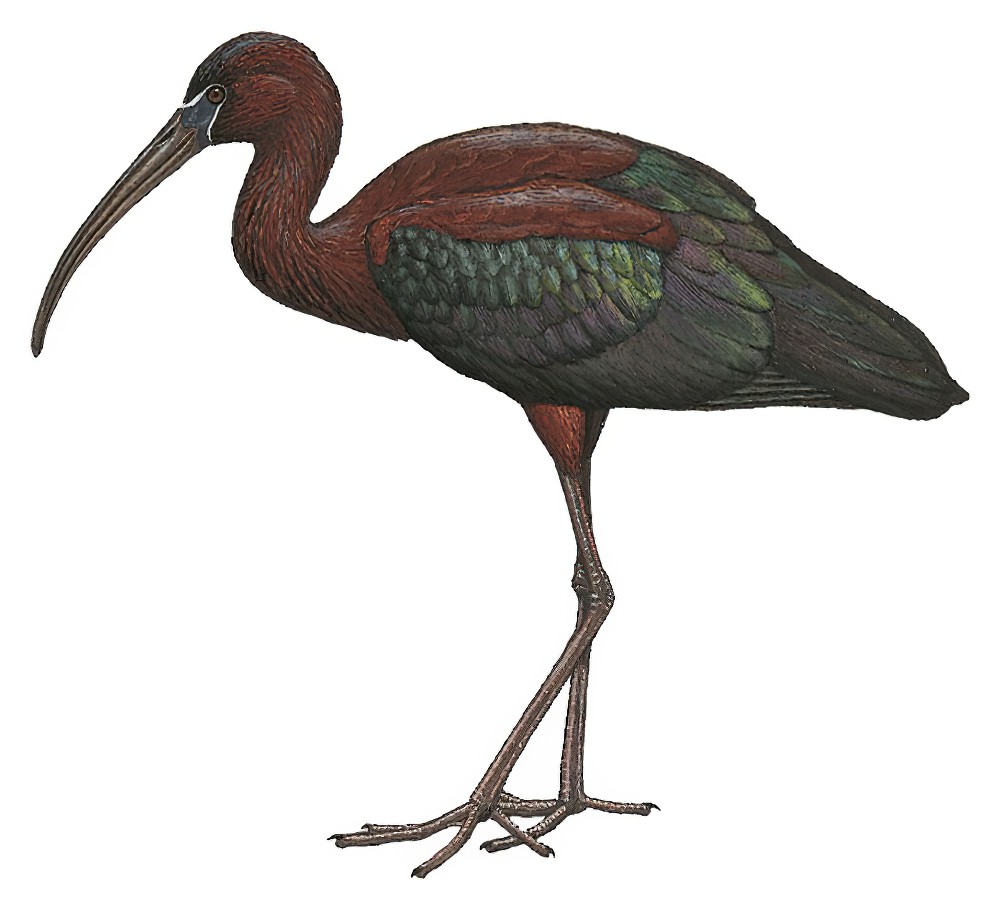Glossy Ibis / Plegadis falcinellus

Glossy Ibis
SCI Name:
Protonym: Tantalus Falcinellus Syst.Nat.ed.12 ed.12 p.241
Taxonomy: Pelecaniformes / Threskiornithidae / Plegadis
Taxonomy Code: gloibi
Type Locality: Java and Celebes.
Author: Linnaeus
Publish Year: 1766
IUCN Status: Least Concern
DEFINITIONS
PLEGADIS
(Threskiornithidae; Ϯ Glossy Ibis P. falcinellus) Gr. πληγας plēgas, πληγαδος plēgados sickle; "7. Ibis falcinellus. ... 7. Sichelschnäbler. Plegadis*), (Ibis falcinellus.) E[ntwickelung]. Alle Körpertheile werden kürzer, die Fußwurzel wird geschildert und das Gefieder einfarbig. Ch[arakter]. Ibisse mit schwarzem Gefieder und geschilderten Füßen. L[ebensart]. Sie nähren sich von Insekten, Würmern und Weichthieren. Unsre europäische Art kömmt auf ihren Zügen regelmäßig nach Ungarn und in die Türkei. ... *) πληγας, Sichel." (Kaup 1829); "Plegadis Kaup, Skizz. Entw.-Gesch., 1829, p. 82. Type, by monotypy, Tantalus falcinellus Linné." (Peters 1931, I, 138).
Synon. Egatheus, Falcinellus, Ibis, Milnea, Plegadornis, Tantalides.
falcinellus
(a) Mod. L. falcinellus with a small sickle < dim. L. falx, falcis sickle, hook.
• "Long broad bill appears heavy, even swollen (at most angles) and has obvious downward kink at tip." (Cramp et al. (eds.) 1983) (OD not yet seen (Pontoppidan, 1763, Danske Atlas, I, p. 623)) (Calidris).
• "140. 2. T. falcinellus *) Nob. Picolaptes squamatus Lafr. (nec Licht.) Mon. Dendr. p. 71. 12. — Dendrocolaptes falcinellus Licht. in Mus. Berol." (Cabanis & Heine 1859); "Small, with slender, notably decurved bill and scaled underparts." (Pearman & Areta 2020) (Lepidocolaptes).
• "Pipilo maculatus falcinellus, new subspecies. ... From Pipilo m. curtatus it differs in slightly longer hind claw" (Swarth 1913) (subsp. Pipilo maculatus) (see falcifer).
(b) Italian name Falcinellus for the Glossy Ibis; "85. TANTALUS. ... Falcinellus. 2. T. facie nigra, pedibus cœruleis, alis caudaque violaceis, corpore castaneo. Numenius rostro arcuato, corpore castaneo, pedibus obscure virentibus. Kram. austr. 350. Numenius viridis. Briss. av. 5. p. 326. t. 27. f. 2.. Falcinellus. Gesn. av. 220. Will. orn. 218. t. 54. Raj. av. 103. n. 3. Falcinellus s. Avis falcata. Aldr. orn. 3. p. 3. 422. t. 423. Mars. danub. 5. p. 42. t. 19. Habitat in Austria, Italia, circa lacus." (Linnaeus 1766) (Plegadis).
Falcinellus
Mod. L. falcinellus little sickle (bird) < dim. L. falx, falcis sickle.
• (Scolopacidae; syn. Calidris † Broad-billed Sandpiper C. falcinellus) "5. Tringa platyrhyncha. ... 5. Regenläufer. Falcinellus. Cuv. Entw[ickelung]. Alle Körpertheile verkleinern sich. Char[akter]. Strandläufer mit bogenförmigem, plattgedrücktem Schnabel. Leb[ensart]. Wie bei Phaeopus." (Kaup 1829); "Falcinellus Kaup, Skizz. Entwick.-Gesch. Nat. Syst. p. 37 (pref. April), 1829. Type (by monotypy): Tringa platyrhynchus Temm. = S. falcinellus Pontopp. Not Vieillot, Analyse, p. 47, 1816." (Mathews, 1927, Syst. Av. Austral., I, p. 178).
• (Scolopacidae; syn. Calidris † Curlew Sandpiper C. ferruginea) "LES FALCINELLES. (FALCINÈLLUS. Cuv.) Dont le bec est déprimé, et conserve ses sillons comme celui des corlieux, mais qui n'ont aucun pouce. Ce sont en quelque sort des sanderlings à bec arqué. On n'en connaît qu'une espèce, qui est de ce pays-ci (Scol. pygmea, Lin.), encore à peu près du même plumage que les courlis et le corlieu, mais à peine de la taille d'une alouette" (Cuvier 1817); "Falcinellus Cuvier, Règne Anim. vol. i. p. 486 (1817=), Dec. 1816. Type (by monotypy): Scol. pygmæa Linn. [= Gmelin] = S. testacea Vroeg. Not of Vieillot, Analyse nouv. Ornith. p. 47, April 1816." (Mathews, 1927, Syst. Av. Austral., I, p. 177).
• (Threkiornithidae; syn. Plegadis † Glossy Ibis P. falcinellus) "FALCINELLUS, Ray. Tantalus, L. Numenius, Briss. Tantalides, Wagl. F. igneus, (Gm.) n. T. falcinellus, L. Hist. d'Égypte, Ois., pl. 7." (G. Gray 1841); "Falcinellus (not of Illiger, 1816) Gray, List Gen. Bds., p. 67, 1841—type, by orig. desig., "F. igneus (Gmelin)" = Tantalus falcinellus Linnaeus." (Hellmayr and Conover, 1948, Cat. Birds Americas, Pt. I (2), p. 264).
• (Promeropidae; syn. Promerops † Cape Sugarbird P. cafer) "166. PROMÉROPS, Falcinellus. Upupa, Linn. Gm. Lath. Bec plus long que la tête, convexe en dessus, comprimé latéralement, arqué, acuminé; mandibule supérieure la plus longue. — Langue courte et pointue, ou médiocre et ciliée à l'extrémité. — Douze rectrices. Esp. Promerops, Buff." (Vieillot 1816); "Falcinellus Vieillot, 1816, Analyse, p. 47. Type, by monotypy, "Promerops" of de Buffon = Merops cafer Linnaeus, 1758." (JAJ 2021).
UPPERCASE: current genus
Uppercase first letter: generic synonym
● and ● See: generic homonyms
lowercase: species and subspecies
●: early names, variants, mispellings
‡: extinct
†: type species
Gr.: ancient Greek
L.: Latin
<: derived from
syn: synonym of
/: separates historical and modern geographic names
ex: based on
TL: type locality
OD: original diagnosis (genus) or original description (species)












